Understanding Fabric Mending Glue for Sustainable Fashion
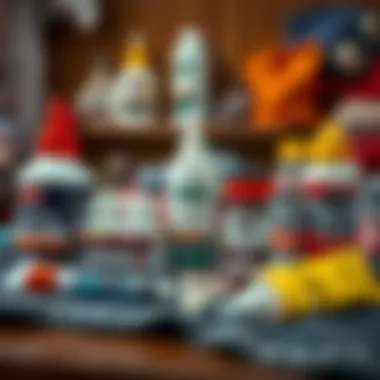
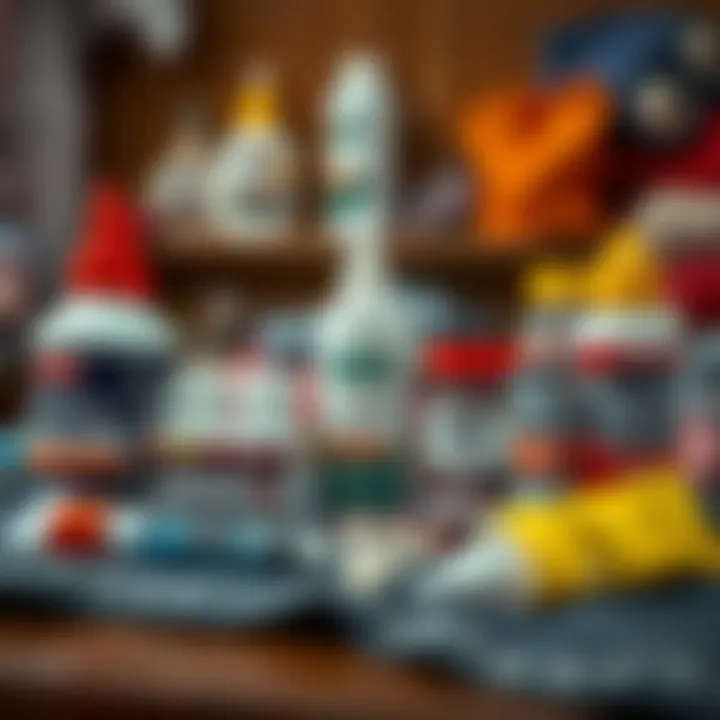
Intro
In the ever-evolving world of fashion, the trends can shift like sand through fingers. Awareness of fabric mending glue is increasingly pivotal, especially among those who cherish both style and sustainability. This guide seeks to shed light on the nuances of fabric mending glue, a tool that's rapidly becoming a staple in wardrobes around the globe.
The allure of fashion does not solely lie in the excitement of new collections hitting the runway; it's also about the stories woven into our garments. From that vintage jacket you can't bear to part with to the soft, worn-out jeans that feel just right, preserving these pieces becomes essential. Enter fabric mending glue—an innovative solution that allows us to extend the life of our favorite clothes without sacrificing style.
As we delve into the depths of this subject, expect to grasp the intricacies of various types of fabric mending glues, their respective applications, and their importance in fostering sustainable fashion practices. Along the way, there will be practical tips, insights into eco-friendly options, and comparisons to alternative garment repair methods that can empower you in your fashion journey.
In today's climate, the call for ethically-sourced fashion and sustainable practices is louder than ever. Understanding fabric mending glue is a step toward a more sustainable wardrobe, reinforcing the notion that every stitch counts. Let’s open the door to a world where you can wear your values and keep your style intact.
Intro to Fabric Mending Glue
Fabric mending glue serves as an essential tool in the realm of textile repair and creativity. It not only offers a way to restore damaged garments but also fosters a growing trend towards sustainability in the fashion industry. In a world where consumption often outpaces ethical considerations, understanding fabric mending glue becomes crucial not just for consumers but for innovators within the sector. This guide endeavors to unfold the various facets of fabric mending glue, emphasizing its types, applications, and benefits.
In this article, we'll explore why utilizing such adhesives can lead to a more sustainable fashion landscape. Each section will delve into various glue types, best practices for application, and the impact these products can have on garment longevity and repair practices, thus helping readers make informed decisions. Whether you're a fashion enthusiast looking to repair your favorite pair of jeans or a retail professional seeking to educate customers, this guide is tailored for you.
Defining Fabric Mending Glue
Fabric mending glue is a specialized adhesive designed to bond fabric materials securely. Unlike regular glues that may disintegrate or fail when faced with washing or stretching, fabric mending glues are engineered to create strong, flexible bonds suited for textiles.
These products can be found in various formulations, including water-based, solvent-based, and heat-activated options. Each type serves different needs, catering to those looking for immediate repairs or those seeking a more permanent solution.
"Mending isn’t just about fixing; it’s about reviving, transforming, and extending the life of textiles."
Historical Context
The use of adhesives in fabric repair is not new. Throughout history, different cultures have devised their methods for mending textiles. Early techniques included stitching and weaving, but as technology progressed, so did our tools. In the 20th century, the advent of modern adhesives marked a significant turning point. Early formulations were often not textile-friendly, leading to practices that sometimes damaged the very fabrics they aimed to help.
With time, the development of better adhesives, particularly in the latter half of the century, focused on achieving durable bonds without harming the material. More recently, with the push toward sustainability, there’s been a resurgence in interest in fabric mending glue. Innovations in adhesive technology are now paving the way toward eco-friendly options, tailored for various applications, balancing convenience and environmental concern.
As we progress further into this guide, it will become clear how fabric mending glue is not merely a quick repair tool but a cornerstone for sustainable fashion practices.
Types of Fabric Mending Glue
Fabric mending glue is not just one-size-fits-all. Understanding the types of fabric mending glue available opens up a world of possibilities for repairs and creative projects. Each type carries its unique properties, making certain glues better suited to specific tasks. Whether you're throwing together a quick fix or embarking on a detailed DIY endeavor, knowing which adhesive to use can save time and frustration.
Water-Based Glue
Water-based glue stands out for its versatility and ease of use. It’s practically child’s play to apply. These adhesives have a milky appearance before drying and tend to dry clear, making them perfect for most fabric colors. Since they are easy to clean up with just a bit of water, they keep mess to a minimum—a big plus for novices or those working on intricate crafts.
However, one must be cautious. While they’re user-friendly and suitable for light to medium fabrics, the bond isn't as strong as other types. For example, patching up a lightweight shirt with water-based glue is an ideal project, but it may not hold up under the strain of a heavy denim. Thus, for significant repairs, it's wise to consider the weight and texture of the fabric involved. If possible, testing the glue on scraps beforehand is a best practice.
"Water-based glues are like the safe bet of fabric adhesives—easy and approachable, but not always the heavyweight champion you might need for tougher jobs."
Solvent-Based Glue
Then we have solvent-based glue, which packs a punch. This type is formulated to provide a robust and enduring hold, ideal for when you need a serious bond. With a chemical base, it penetrates the fibers of the fabric, creating a stronger connection than many alternative options. If you’re mending a sturdy canvas or doing upholstery work, solvent-based glue shines here.
However, it does come with a few strings attached. The strong fumes can be off-putting, and adequate ventilation is a must when using this adhesive. Also, cleanup requires a different approach, often needing solvents such as rubbing alcohol, which makes it less convenient than its water-based counterpart. Nonetheless, when the goal is longevity, solvent-based glue is often the right path to take. Just make sure to handle it with the respect it deserves.
Heat-Activated Adhesives
Heat-activated adhesives, often found in the form of tape or specific glue products, work their magic through a little bit of heat. You simply apply heat, usually from an iron, and voilà! The glue activates, bonding the fabric tightly. This method is pretty nifty for repairs that need to be not just durable but also discreet. The bond created is often unexpected—strong and flexible, allowing the fabric to retain its natural movement.
Using heat-activated adhesives may take a bit of practice, especially in gauging the right temperature and time for various materials. But when done correctly, the results can be essentially seamless. Another benefit? They're often more resistant to washing, which is a blessing in the world of textile care.
In summary, the world of fabric mending glue is richly layered, with each type catering to different needs and preferences. Understanding these distinctions can empower you to choose the best fabric mending solution for your project.
Applications of Fabric Mending Glue
Fabric mending glue finds its relevance across various situations, playing a vital role in both everyday repairs and creative projects. Its capabilities extend beyond quick fixes; it opens up a world where garments can be restored, creations can flourish, and waste can be minimized. This section elaborates on three primary applications: altering garments, indulging in crafting affairs, and catering to upholstery needs.
Quick Repairs for Garments
When a button pops off or a small tear appears, reaching for fabric mending glue can be a swift and practical solution. Garment repairs often demand immediate attention, and fabric mending glue offers a time-efficient approach. The beauty of this adhesive lies in its ability to bond without the need for time-consuming sewing. A dab of glue here and there can make the difference between wearing a favorite shirt or opting to toss it aside.
- Advantages of Quick Repairs:
- Efficiency: No waiting for sewing tasks to be completed means one can wear their mended garment promptly.
- Minimal Skill Required: Even those who aren’t sewing aficionados can apply glue with a steady hand.
- Versatility: Works on various fabrics, making it suitable for different clothing types.
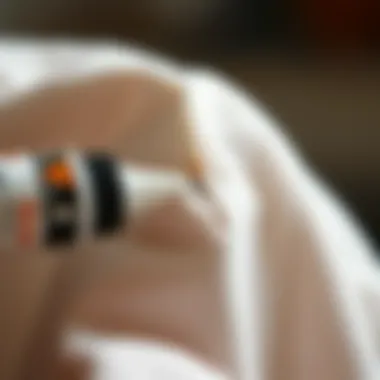
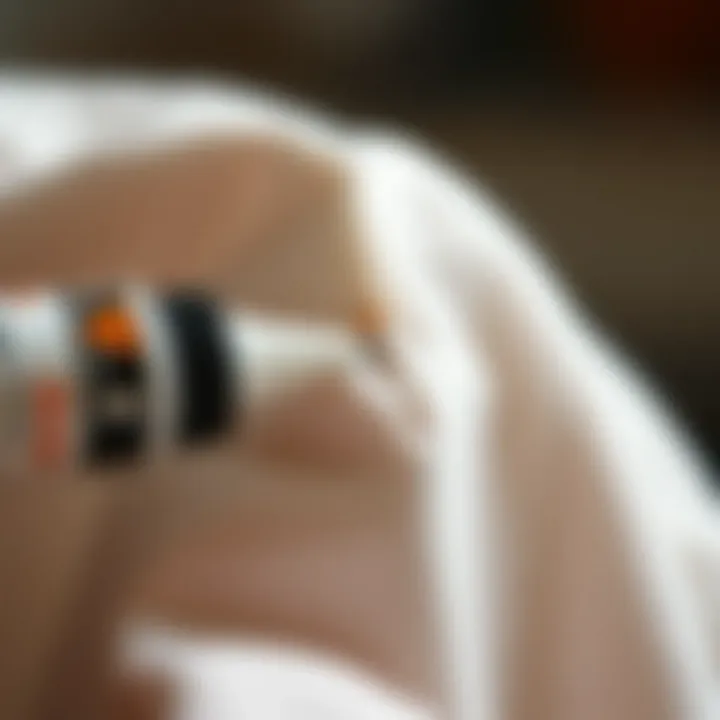
However, garment repair with glue requires some thought. Different fabrics react differently to adhesives, and a wrong choice can lead to undesirable outcomes. Not every glue is suitable for every fabric, so it’s wise to check the label for recommendations. Additionally, avoiding exposure to water until the glue fully dries is essential. Patience in waiting for curing ensures a robust repair that won’t give way at the worst moment.
Crafting and DIY Projects
Fabric mending glue isn't just for those hasty repairs; it thrives in the creative realm too. Whether you're enhancing an old jacket, making patches for a backpack, or whipping up a fabric art piece, this adhesive can elevate your DIY endeavors. The bond it forms can withstand stress, allowing creative minds the freedom to explore.
Some notable uses in crafting include:
- Attaching fabric embellishments like lace or buttons to clothing.
- Creating fabric collage art for home decor.
- Making customized gift wraps from leftover fabric remnants.
During crafting, to achieve neat results, apply the glue sparingly. An overabundance can seep out from under the fabric, creating a mess. Have a wet cloth handy to quickly zap any glue that escapes its borders. This nimble approach lets creativity shine without the clutter of an adhesive disaster.
Upholstery Uses
When it comes to upholstery, fabric mending glue can be a game changer. Restoring old furniture pieces or tackling minor damages turns less daunting with the right adhesive. Whether it’s reinforcing seams or fixing distressed areas, fabric glue can be a reliable ally.
- Major Benefits for Upholstery:
- Strengthening: It provides a strong bond that can reinforce weakened areas that sewing alone might not effectively repair.
- Convenience: Tackling upholstery repairs can often be intensive, and fabric glues save time while ensuring solidity.
- Flexibility: Adapts well to various upholstery fabrics, enhancing the chances of effective restoration.
Upholstery projects do take careful preparation. The fabric surfaces need cleaning and drying thoroughly before adhesive application for the best grip. A clean surface ensures no dirt or grease interferes with the bond, leading to a more successful repair.
The Benefits of Using Fabric Mending Glue
Fabric mending glue has become a staple in the toolkit of anyone interested in maintaining and repairing textiles. Beyond just sticking two pieces of fabric together, this adhesive offers a plethora of advantages that align with the needs of modern fashion enthusiasts and retail professionals. Understanding its benefits can transform one’s approach to garment maintenance, making it not only a practical choice but also a smart one from both an economic and environmentally friendly standpoint.
Cost-Effective Solutions
In today’s world, where prices for quality clothing can hit the roof, fabric mending glue emerges as a game-changer. Repairing rather than replacing damaged items saves not just money but also resources. For instance, instead of shelling out a small fortune for a tailor, a few drops of a strong adhesive can work wonders on small rips or seam separations.
The cost-effectiveness of using fabric mending glue can be illustrated through a simple comparison:
- Regular Fabric Repair: Tailoring services often charge anywhere from $15 to $50 for minor repairs, depending on the fabric and the intricacy of the job.
- Using Fabric Mending Glue: A tube of good-quality fabric glue typically ranges from $5 to $15, providing a significant saving.
Moreover, consider the long-term savings—by regularly maintaining garments with mending glue, one can extend the life of their wardrobe, delaying the inevitable need to purchase new clothing. It's like patching a hole in your pocket rather than reaching for your wallet repeatedly.
Time-Saving Aspect
Time is a precious commodity, especially for busy individuals. Fabric mending glue is not only straightforward to use but also significantly reduces the total time spent on fabric repairs. While sewing can often require careful measuring, pinning, and meticulous stitching, applying fabric glue can be done swiftly.
For example, let’s say a hem comes undone on your favorite pair of trousers. With a needle and thread, it may take a good half an hour to repair.* In contrast, a quick application of fabric glue can have that same hem looking as good as new in merely five to ten minutes, allowing you to spend your time where it truly matters.
"Time saved is time earned" - a practical motto for those looking to streamline their fabric care routines.
Permanent Bonding
When it comes to the durability of repairs, fabric mending glue can offer an almost permanent bond when applied correctly. This means fewer worries about seams giving way or patches peeling off after a wash. The modern formulations are designed to withstand frequent washing and wear, providing a lasting hold that traditional sewing sometimes cannot match.
Consider these points:
- Flexibility: Unlike stitches, fabric mending glue allows for more flexibility in movements, making it preferable for active wear or garments subjected to regular stress.
- Invisible Finish: A properly applied layer of fabric glue can be virtually invisible once dried, preserving the aesthetic of your garments while still providing strong support.
In closing, employing fabric mending glue not only contributes to substantial savings in time and money but also ensures long-lasting repairs. By integrating this handy tool into your fabric care practices, you’re not only making smart choices for your wardrobe but also nurturing a more sustainable approach to fashion. The more you know, the easier it becomes to extend the life of your cherished pieces.
Challenges and Limitations
As we delve into the realm of fabric mending glue, it becomes imperative to acknowledge the challenges and limitations that accompany its use. While this adhesive offers numerous benefits, it's not without its pitfalls. Understanding these potential drawbacks equips users—particularly fashion enthusiasts and retail professionals—with the knowledge necessary to weigh their options effectively.
Potential Damage to Fabric
One of the primary concerns surrounding fabric mending glue is the possibility of damage to the fabric itself. Adhesives can sometimes react unpredictably with various textile fibers. For instance, some glues might discolor fabrics or cause them to become stiff, undermining the garment's original flexibility and softness. This risk varies from material to material; silk and polyester, for example, can be particularly sensitive.
Before applying any adhesive, it’s crucial to conduct a patch test on a hidden area to observe any adverse effects. Moreover, using excess glue can also lead to unsightly lumps, creating a less than appealing finish.
"Choosing the right fabric mending glue involves a balance between effectiveness and safety. Always prioritize a compatibility check before committing to the adhesive."
Drying and Curing Time
Another point of consideration relates to the drying and curing time associated with fabric mending glue. Unlike sewing, which offers instant results, fabric adhesives typically require a waiting period before achieving a solid bond. This latency can be annoying for individuals eager to see immediate fixes. Depending on the type, some glues can take hours or even days to cure completely. Heat-activated adhesives, while effective, often demand high temperatures and time to form a reliable bond.
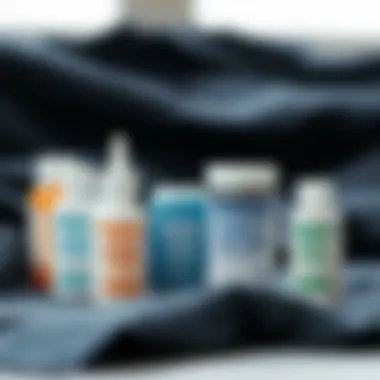
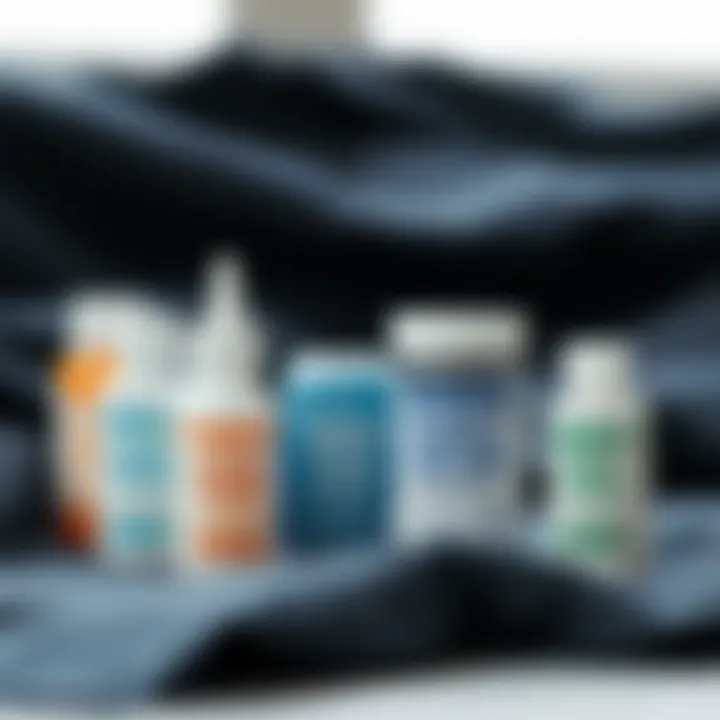
Patience is key when using these products. Users should plan their projects accordingly, allowing ample time for the glue to dry to avoid premature pulls or tears in the repair area.
In summation, while fabric mending glues present attractive solutions for fabric repair, they should be approached with caution. The potential for damage and drying time limitations stresses the need for careful evaluation and informed decision-making in fabric care.
Comparing Fabric Mending Glue with Other Repair Methods
When it comes to repairing fabric, options abound. Each method has its own strengths and weaknesses. Understanding these can help you make an informed decision based on your specific needs. This section dives into the comparison of fabric mending glue with other repair techniques, such as traditional sewing and iron-on patches.
Sewing vs. Glue
Sewing has long been the tried-and-true method for fabric repairs. It's reliable and familiar to many. A needle and thread can fix everything from a simple hem to a complex tear. However, it does require a certain level of skill and patience, and it can be time-consuming. For those who lack sewing experience, this may not be the best route. Here are some of the key elements to consider:
- Durability: Sewn repairs often hold up better over time, especially under stress.
- Flexibility: Sewing allows for the fabric to maintain its natural drape and flow, whereas some glues can create a stiffer area.
- Skill Level: Not everyone is comfortable with needlework. Fabric mending glue provides a straightforward solution without the learning curve.
- Speed: Gluing can often be done in moments. Just apply, press, and you're done; no stitching or meticulous measuring required.
Ultimately, the choice between sewing and glue comes down to the specific application and personal preference. For quick fixes or for those who aren’t handy with a needle, fabric mending glue stands tall as a viable alternative.
Iron-On Patches
Ah, iron-on patches. Who hasn’t used one at some point? These patches offer a nostalgic nod to the past while being a practical solution for repairs. Iron-on patches typically boast decorative qualities, making them an appealing option for embellishments as well. Nonetheless, they also come with their own set of pros and cons:
- Ease of Use: They require minimal skill. Just heat the iron and press. Simple as pie.
- Coverage: Patches can cover larger areas of damage, making them suitable for big rips, especially on heavy fabrics.
- Aesthetic Appeal: Many come in vibrant designs, allowing an injured piece of clothing to take on a new character.
- Adhesion: Iron-on patches can sometimes peel off, especially after multiple washes, which can lead to future repairs being necessary sooner than desired.
In contrast, fabric mending glue provides a seamless repair option, allowing you to fix fabric without the added bulk of a patch. Moreover, it avoids the potential of an aesthetic clash between your material and the patch being used.
Comparing these methods highlights that while sewing, iron-on patches, and fabric mending glue serve similar purposes, they do so in distinct ways. Each technique has its own niche, and being well-informed on these can enhance your repairs significantly.
"Choosing the right repair method can be the difference between a lasting fix and a temporary solution. Consider your fabric type, the nature of the damage, and of course, your comfort level with various techniques."
For further reading on sewing techniques and fabric repairs, you can check out resources like Wikipedia or Britannica.
By weighing the pros and cons, you’ll find the method that best suits your capabilities and requirements, whether you’re just patching up a favorite old shirt or undertaking a more adventurous DIY project.
Eco-Friendly Fabric Mending Options
The significance of eco-friendly fabric mending options in contemporary fashion cannot be overstated. As environmental concerns grow, consumers are increasingly attentive to how their purchasing decisions affect the planet. Fabric mending glue, once overlooked in sustainability discussions, has emerged as a critical element in extending the life of garments and reducing waste. By embracing eco-friendly practices, both consumers and manufacturers can contribute towards a more sustainable fashion ecosystem.
Biodegradable Adhesives
Biodegradable adhesives represent a remarkable shift in the fabric mending landscape. These glues are designed to break down over time, minimizing their impact on the environment after disposal. Unlike traditional glues that may persist in landfills for decades, biodegradable options contribute to a more circular economy. Their ingredients are typically derived from natural sources, such as plant-based materials, which makes them safer for both users and the environment.
Some key benefits of using biodegradable adhesives include:
- Reduced Environmental Footprint: As they break down naturally, they lessen pollution and landfill waste.
- Healthier for Users: By opting for natural components, these adhesive options are generally free from harmful solvents often found in conventional glues.
- Enhanced Longevity for Garments: By using adhesives that facilitate repairs, you enable garments to enjoy a longer lifespan, offsetting the need for constant buying of new items.
However, there are a couple of considerations. Biodegradable adhesives can sometimes have a shorter shelf life compared to their conventional counterparts, so proper storage is critical to avoid loss of efficacy. Additionally, they may not yet be widely available in all markets.
Sustainable Sourcing Practices
Sustainable sourcing practices in the production of fabric mending glues focus on responsible procurement of raw materials. This concept hinges on the idea that the materials used in the manufacturing process should be renewable, ethically sourced, or less harmful to the surrounding ecosystems. For instance, manufacturers can partner with local suppliers to decrease carbon footprints associated with transportation.
Practicing sustainability in sourcing offers multiple benefits:
- Support Local Economies: When brands prioritize local sourcing, they bolster their communities and foster economic growth.
- Enhance Transparency: Sustainable sourcing provides consumers with clearer, honest information regarding product origins, allowing them to make informed choices.
- Alignment with Ethical Standards: Using materials sourced responsibly adheres to ethical guidelines, appealing to consumer bases that prioritize corporate social responsibility.
To sum it all up, embracing eco-friendly fabric mending options, including biodegradable adhesives and sustainable sourcing practices, is essential for anyone committed to a sustainable fashion approach. As fashion challenges traditional norms regarding consumption and waste, it reminds us that small changes, like which glue to choose, can have a lasting impact.
"Sustainability is not just a trend; it's a need for our planet's future."
For more on sustainable practices in the fashion industry, you can explore The Guardian, or delve into insights on Forbes.
Practical Tips for Using Fabric Mending Glue
Using fabric mending glue is not just about slapping the stuff on and hoping for the best. To achieve a lasting repair, knowing the right techniques matters just as much as choosing the right glue. Fabric mending glue can save garments and help maintain your overall style, making it crucial for a repair strategy in any wardrobe or crafting toolkit.
Preparing Fabric for Adhesion
Before you even think about applying glue, a little prep work goes a long way. Here’s what you should keep in mind:
- Clean the Fabric: Make sure the area to be repaired is clean from dirt, dust, and oils. These contaminants can seriously mess with how well the glue sticks. A simple wipe-down with a damp cloth can do wonders.
- Dry Completely: After you've cleaned, let the fabric dry thoroughly. Wet fabric can prevent the adhesive from creating a solid bond, so patience is key here.
- Trim Loose Threads: If you’ve got loose threads or frayed edges, trim them neatly before applying the glue. A clean edge helps the bond to lay flat, reducing the chances of future loosening.
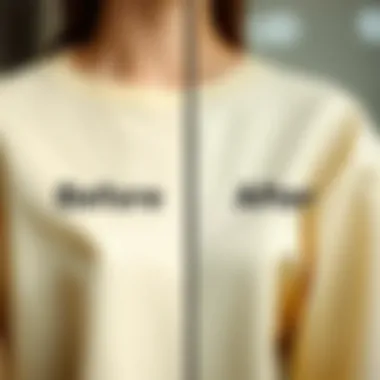
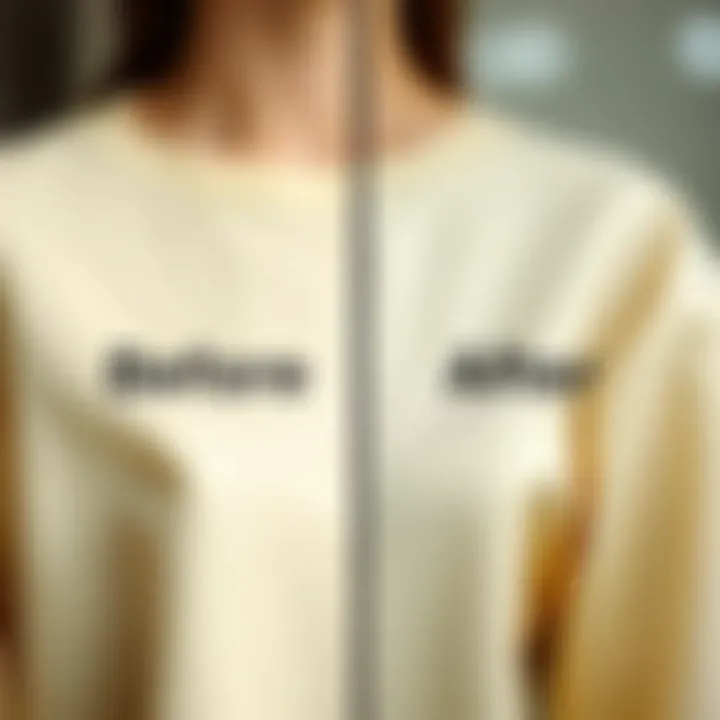
"A stitch in time saves nine." This old adage fits well here. Putting in the effort before application can save you trouble down the road.
Some materials also require special treatment. For instance, slippery fabrics like silk can be challenging. In such cases, utilizing a fabric stabilizer before applying adhesive can offer a better surface for the glue to grip onto. This extra step might seem tedious, but think of it as a safety net for that beautiful garment.
Proper Application Techniques
Getting the application right is just as vital as preparing the fabric. Here’s how to do it like a pro:
- Use a Small Amount: Start with a tiny bit of glue. Overapplying can lead to messy results that are hard to clean up. Think of it as frosting a cake—you can always add more, but taking away is difficult.
- Spread Evenly: For smooth application, use a small brush or a toothpick to spread the glue evenly across the fabric. Uneven layers create weak points where the glue might break down quicker.
- Align Carefully: If you’re gluing two pieces together, give special attention to aligning them correctly. Once the glue sets, it’s challenging to reposition without ruining the fabric.
- Apply Pressure: After positioning the patched area or fabric piece, apply firm pressure. Keeping the two pieces pressed together for a few minutes will ensure that the adhesive sets properly and bonds thoroughly.
- Follow Drying Instructions: Always check the manufacturer's instructions regarding drying time. Rushing this step can lead to a failed bond. Just because it feels dry to the touch doesn’t mean it’s ready for use.
In summary, preparation and application are the cornerstones of successful fabric mending glue usage. Following these detailed steps can save you both time and money, while also offering a chance to flex your creative muscles in the process.
Significance in Sustainable Fashion
In today’s rapidly evolving world of fashion, the quest for sustainability has taken center stage. Fabrics, once deemed disposable, now receive fresh perspectives through the lens of mending and repair. Fabric mending glue plays a crucial role in this movement. It is not just a handy tool for quick fixes, but rather a vital component in redefining our relationship with clothing.
Extending Garment Life
In an era where ‘wear and toss’ seems all too common, fabric mending glue offers an alternative narrative. By enabling us to repair our garments, it significantly extends their life. Imagine a favorite jacket, frayed and tearing at the seams—rather than discarding it, a dab of mending glue can breathe new life into such pieces. It is often underestimated how a simple task, like applying glue, can save a garment from an untimely fate in a landfill.
Notably, this practice of mending aligns with the principles of conscious consumerism. More and more, individuals are seeking out quality over quantity—choosing pieces that they can cherish and maintain over time. Regularly using fabric mending glue means investing in the longevity of your wardrobe, thus fostering a more sustainable lifestyle. Beyond that, it empowers individuals to take control of their clothing, fostering creativity and personalization.
Reducing Fast Fashion Impact
Fast fashion has been the scourge of the industry, encouraging relentless consumption at the expense of our planet. Fabric mending glue can be viewed as a quiet rebellion against this cycle. By repairing our clothes instead of purchasing new ones, we reduce our demand for fast fashion.
Here are some key benefits:
- Plastic Consumption: Every new piece of clothing contributes to plastic pollution, from the fibers to the packaging. Repairing clothes can cut down on the resources and energy used in production.
- Waste Reduction: The more we mend, the less we throw away. This plays into the growing movement of zero waste, which seeks to minimize our ecological footprint.
- Environmental Awareness: Embracing mending methods aids in raising awareness about sustainable practices within our communities. As one person begins to mend, it often encourages others to follow suit.
In summary, the significance of fabric mending glue extends far beyond mere convenience. In the grand tapestry of sustainable fashion, it is a thread that weaves together individual choice, community awareness, and environmental responsibility. Embracing such practices will undoubtedly initiate a shift toward rethinking fashion consumption and foster a more sustainable future in which garments are respected and preserved rather than rapidly discarded.
The Future of Fabric Mending Techniques
As we peek into the horizon of fabric mending methods, it becomes clear that we are in an era ripe for transformation. The intersection between technology and textiles opens new doors for creativity, sustainability, and efficiency. It’s somewhat like standing at the precipice of a new world, where traditional practices blend seamlessly with cutting-edge innovations. Understanding the future of fabric mending techniques not only prepares aficionados and professionals for what’s coming but also shapes how we engage with materials, fostering a culture that honors both craftsmanship and environmental consciousness.
Innovations in Adhesive Technology
Adhesive technology is experiencing a renaissance, akin to a phoenix rising from the ashes. Companies are pouring resources into research and development, leading to breakthroughs that might sound like something out of a sci-fi film. One such advancement is the formulation of smart adhesives, which respond to various stimuli such as heat or moisture, adapting to changes in their environment. These adhesives can offer flexibility that traditional glues simply can't match.
Moreover, eco-conscious innovations are gaining momentum. Biobased adhesives created from renewable resources are becoming increasingly popular. These kinds of adhesives not only offer strong bonds but also ensure that the environmental footprint is minimized. It is essential to recognize that choosing these options contributes significantly to sustainable fashion. Instead of shying away from maturity, manufacturers are embracing this shift and enhancing their line of products with sustainable solutions. It’s like giving fabric a second chance while keeping Mother Earth happy at the same time.
Benefits of such innovations are manifold:
- Increased durability in mended seams, leading to longer garment life.
- The ability to combine flexible and rigid materials, enhancing design possibilities.
- Reduction in harmful chemicals in the manufacturing process, enhancing safety for users.
Ultimately, it is the combination of creativity and responsibility that shapes the future landscape of fabric mending techniques, encouraging a holistic approach to problem-solving in the textile industry.
Consumer Trends and Preferences
As consumers evolve, so do their preferences, shaping industries in unexpected ways. The rising trend of personalization in fashion signifies a growing desire for individuality, with a noticeable shift towards unique, custom-made pieces rather than mass production. This insatiable appetite for personalization directly impacts fabric mending techniques, changing how adhesives and repair methods are viewed.
Buyers are more inclined toward brands that showcase transparency regarding their materials and practices. People want to know what goes into the products they purchase. More than mere consumers, they’re becoming advocates for sustainability. They look for brands that practice ethical sourcing and offer repair solutions that align with these values.
This shift influences the types of adhesives manufacturers develop. Fabric mending glues are being marketed not just as solutions for repairs but as tools that enable consumers to express their craftsmanship and individuality through alterations and repairs.
Some key trends include:
- A surge in DIY culture, with more people learning how to repair their clothing.
- Increased participation in workshops focusing on mending and upcycling skills.
- Preference for multifunctional products that serve more than one purpose, such as fabric mending glue that can also be used in crafting.
To encapsulate, the future of fabric mending techniques is being shaped by technological advancements in adhesives and a consumer base that's increasingly discerning and aware of their impact. It’s an exciting time for fashion enthusiasts and retail professionals alike as they adapt to these transformative changes.
Culmination
In wrapping up our exploration of fabric mending glue, it's clear that this adhesive tool is not just a mere convenience for quick fixes—it's a vital component in sustaining our wardrobe and the environment. As we've discussed throughout this guide, the significance of this topic lies in several key areas that contribute positively to both our daily lifestyles and the broader scope of sustainable fashion.
Recap of Key Points
- Types and Applications: We began by identifying various types of fabric mending glue, including water-based and solvent-based, each serving different needs across garment repairs, crafting, and upholstery.
- Benefits: We highlighted how this solution not only saves time and money but creates a permanent bond that may outlast the unglued fabric.
- Challenges: While acknowledging some limitations, such as potential damage to delicate fabrics and the waiting game during the drying and curing process, these challenges can often be navigated with a bit of careful application.
- Sustainable Fashion: Furthermore, we underscored the glue's role in elongating the lifespan of clothing, thus combating fast fashion's impact on our planet. This extends beyond individual choices and taps into a collective movement towards greener fashion practices.
- Future Trends: Innovations in adhesive technology and a shift in consumer preferences point toward a promising future for fabric mending practices.
Final Thoughts on Fabric Mending Glue
The journey through the realm of fabric mending glue reveals it to be more than just an adhesive. It encapsulates the value of resourcefulness in an era plagued by disposable fashion habits. As fashion enthusiasts and retail professionals alike seek to balance style with sustainability, fabric mending glue emerges as a powerful ally. It empowers individuals to take charge of their clothing, reduce waste, and cultivate a mindset of repair rather than replacement.
In a world where every stitch counts, understanding and utilizing fabric mending glue may very well become an essential skill that bridges the gap between creativity and sustainability, ensuring that our garments tell a story of care and longevity rather than fleeting trends.







